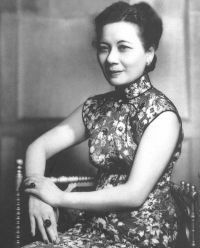Soong May-ling
Soong May-ling (宋美龄, March 5, 1898 – Oct. 23, 2003), also known as Madam Chiang Kai-shek, was an influential diplomat, politician and social activist during the 20th century. Best known for her lobbying and address to the U.S. Congress during World War II, she was considered by many Americans a charismatic Chinese woman who spoke fluent English and held a political stance in allying with the U.S.
But her appraisal in China, which has been undergoing a century-long anti-feudalism and anti-colonialism struggle to build a modern and independent country, is quite complicated. She was recognized for her relentless efforts to defend China against the Japanese invasion during the Anti-Japanese Aggression War (1937 – 1945), but she was also criticized for her endless pursuit for a privileged life, which caused a rift between her and a poverty-stricken majority in China at that time.
Born to an affluent Methodist’s family in Shanghai, the young Soong was sent to America when she was 11 with her sister Qing-ling. She studied in a private school in New Jersey, Piedmont College and Wesleyan College before enrolling at Wellesley College, where she graduated with a major in English literature in 1917. She was fully Westernized by her U.S. education, and famously said once that the only oriental thing about her was her face.
Soong returned to Shanghai after her graduation, where she had to learn Chinese quickly to integrate into the local society. Strong-minded and independent, she remained single at the age when many of the girls from rich families married. Refusing many of her suitors, she declared she would rather be an old maid than marry a Chinese tycoon. But she became enamored with Chiang Kai-shek, who was then a military official and Buddhist who had already married three times. Soong’s relation with Chiang was strongly opposed by her family at first. But with Chiang’s conversion to Christianity and the support of her oldest sister, Ai-ling, Soong’s mother finally approved of the marriage. In 1927, Chiang and Soong held a grand wedding ceremony in Shanghai, and many newspapers predicted the marriage to mark Chiang’s pro-US political standpoint.
With Chiang’s rise to power after his purge of the Communists that year, Soong became the first First Lady of the Republic of China (1911-1949). Amassing enormous power and proving herself a working wife, Soong was soon involved in the politic life in China. She initiated the New Life Movement, became a participant in the peaceful settlement of the Xi’an Incident and worked as Secretary-General of the Chinese Aeronautical Affairs Commission from 1936 to 1938. Those made her an attractive woman to foreign media. In 1937, she and Chiang appeared as the first Time Magazine’ s "Man and Wife of the Year." On Feb. 18, 1943, she became the first Chinese and second woman to address both houses of U.S. Congress. She also assisted Chiang in negotiating with Franklin Roosevelt, Winston Churchill and Joseph Stalin for China’s cause at the end of World War II.
After the Kuomintang was defeated in the Chinese Civil War, she accompanied her husband to retreat to Taiwan and took up painting. With Churchill’s Iron Curtain speech, an invisible ideological conflict separated her with her sister Ching-ling, who sided with the Communist Party during the Cold War. She gave up the last chance to meet Ching-ling in Beijing, despite her sister’s dying wish. After her husband’s death in 1975, she spent most of her time living in the U.S. She died in her sleep in 2003 at the age of 106.
